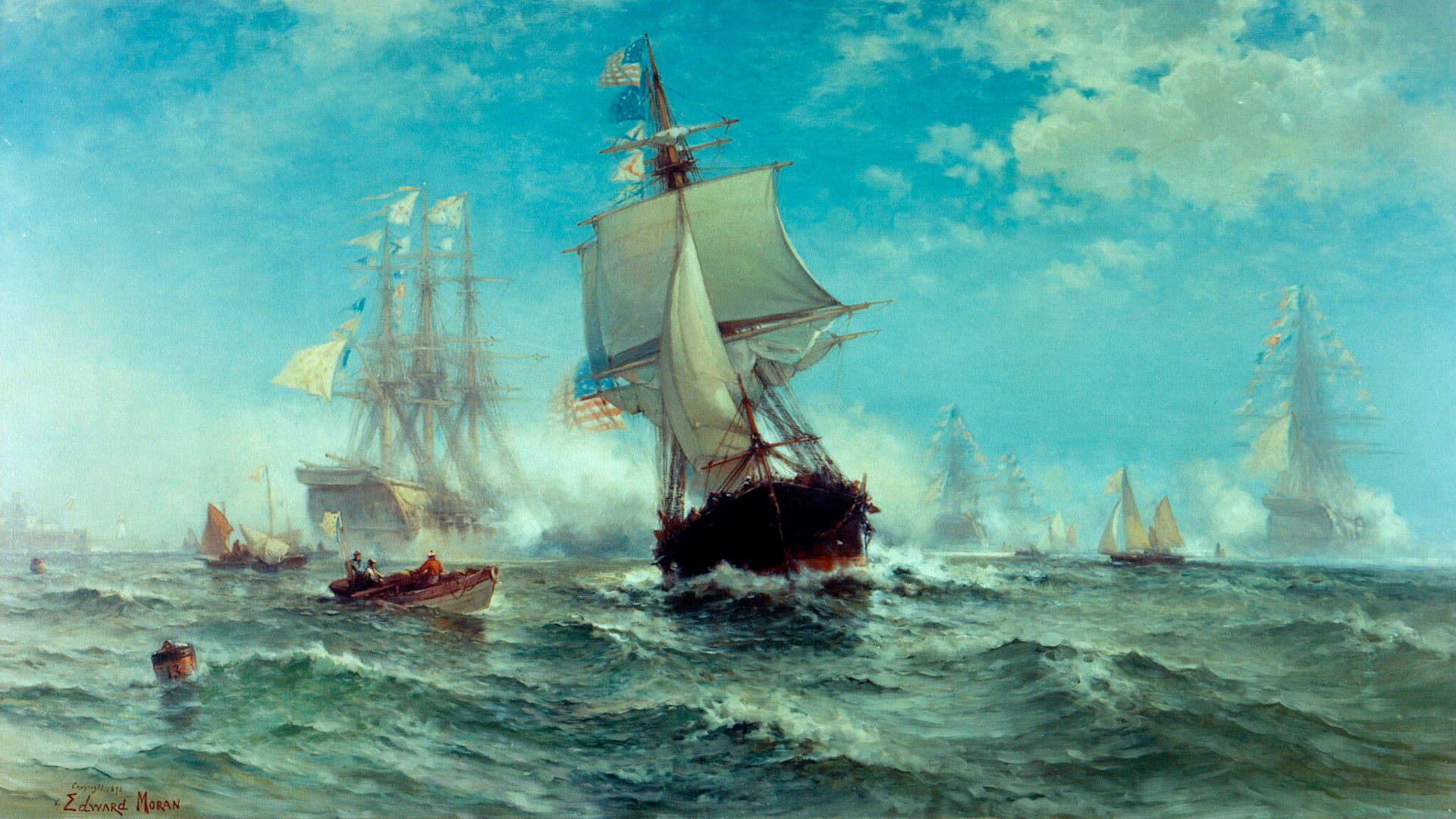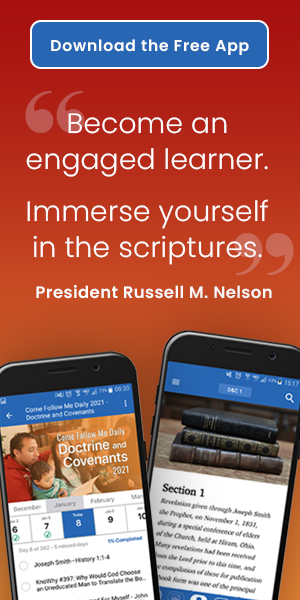You are here
How Do Latter-day Saints See God‘s Hand in History?

1 Nephi 13:13, 19
The Know
The idea that God plays a significant role in certain historical developments and events, known by the term providential history, is one of the foundational ideas of Latter-day Saint scripture; all of the standard works foretell or describe historic events and assert that God’s mind, will, and hand influenced them in some guiding way. Yet this idea is by no means a well-accepted view in the modern world.1 Atheism rules out the existence of God, precluding the thought that God plays a role in history; Deist views suggest that God created the world and its laws but no longer interacts directly with His creation. Agnostics, skeptics, and even some believers say that although God may guide history, it is impossible to know when God has guided it.2
From a faithful perspective and with the aid of divine revelation, however, it is possible to see and to affirm that God’s mind and will have played important roles in planning, foreseeing, and providing for various means and circumstances that will allow His will to be done. Such orderly developments can be seen standing behind the complex, purposeful, and orchestrated unfolding of amazing events in the lives of God’s children here on this earth. Coming to this composite observation that the Lord brings about His great and marvelous divine plans in human affairs through an array of small and sometimes unwitting human means is what can be called doing providential history.
In the Book of Mormon, Nephi and the prophet-historians who followed him provide several depictions of what an understanding of providential history may look like.3 For example, Nephi gives readers a short providential summary of events familiar to modern history. Nephi foresaw not only the ministry of Christ among the Jews and the history of the Nephites (1 Nephi 11–12) but also the events leading up to the Restoration of the Church of Jesus Christ and advent of the Book of Mormon in Joseph Smith’s day. He saw a preview of the colonization of the Americas by Europeans, the independence of these colonies from European control, the proliferation of the Bible among them, the establishment of the Church, and the thorny but significant relationships and conflicts between the settlers and Indigenous peoples (1 Nephi 13).4
While these were future events discerned prophetically by Nephi, they are now historical events from a modern perspective. This affords readers today the opportunity to look at Nephi’s ancient vision through the lens of providential history and discern key lessons. First, notice the concentrated recurrence of themes such as relief from bondage and knowledge of God and His righteousness, liberty, accountability, humility, and peace. When these factors increase and purposefully coalesce in human history in ways that do not appear to be random happenstances, it is reasonable to acknowledge that God may have been involved.
Behind such developments appear to be certain divine laws and grand principles that can be detected and extrapolated—namely, that God gives power to those who are humble so that they can obtain liberty, that those who lack knowledge of God will stumble, that those who are ignorant are not accountable, and that the righteous generally, but not always, experience peace (1 Nephi 13:16, 20, 29, 32–33). These principles can broadly be applied to the narrative to explain why key events in history occurred.
Interlaced with those principles, the prophetic narrative is framed by divine promises that God will gather Israel—including through adoption and rediscovery of lost ancestry—and that destruction will come on those dwelling in the promised land of the Americas if they neglect His laws (1 Nephi 13:37–42; Ether 2:9–12). The Lord also promises here that the Nephites will not be totally destroyed, nor will the Gentiles be in perpetual ignorance, and that God will begin to transmit knowledge of ancient Lehites to Indigenous peoples by means of the Gentiles, building a reciprocal relationship of healing after long centuries of generational traumas (1 Nephi 13:30–32, 34–39).
Lastly, Nephi forecasts the negative consequences resulting from generations of apostasy among both the Gentiles and descendants of the Lamanites, such as the ignorance of the Gentiles, the omission of truths from the Bible, and the horrors that came upon Indigenous Americans in the colonization process (1 Nephi 13:14, 26–29, 32, 34). These are not necessarily prescriptions of what God desired or willed to happen, but they are descriptions of what God eventually allowed to happen as consequences of wickedness and apostasy.
The Why
A number of factors show why it makes good sense to speak of Nephi’s vision in 1 Nephi 11–14 as a prime example of providential history. Nephi saw in vision God’s hand in the extremely complex set of future events that have unfolded in the intervening centuries, especially leading up to and making possible the coming forth of the Book of Mormon and the Restoration of the gospel of Jesus Christ.
From a historical perspective, looking back on the unfolding of these events, one can see logical and significant ways in which God was able to foresee (Latin provideo) future happenings and provide for the extraordinary confluence of necessary and sufficient circumstances that allowed His chosen and empowered agents to bring to pass His desired outcomes.
Recognizing and understanding such numerous intersecting factors can help readers apply some of the same principles at work in their own lives and in modern world events to thus see God’s hand at work on both the individual and global scale. The first and most important factor is revelation. It is primarily through the revelation that Nephi receives that he is able to know and forecast the roles that God has played in early American history and in world history generally. Though most readers may not be prophets, all can tentatively use the revelation boldly given by prophets to understand both the events they describe and other events that they haven’t since revelation provides “a pattern in all things.”5 Historian Roy A. Prete has noted:
As the Book of Mormon prophet Jacob pointed out, no one can know the works of God and his ways “save it be revealed unto him” (Jacob 4:8). But Latter-day Saints enjoy the additional light of modern revelation, which provides at least some guidance about God’s role in history. While God has not chosen to speak on every matter, and statements on his role in history have been fragmentary and incomplete, the additional scriptures of the Restoration and the statements of modern prophets and apostles provide Latter-day Saints with fresh insights into the role of God in the shaping of modern history.6
Second, Nephi and other Book of Mormon prophets see the hand of God in both the miraculous and the mundane. This stands in vigorous contrast to the Deism popular in Joseph Smith’s day.7 Restoration scripture teaches that God upholds all natural law, and so God’s hand need not be seen only in events that seem to defy natural law and probability (Doctrine and Covenants 88:7–13, 41–50). Certainly, miracles of an extraordinary nature will continue to occur. At the same time, Latter-day Saints should see God’s presence in seemingly ordinary events and processes. This allows all people to begin to look for a divine hand less in terms of statistical probabilities and more in terms of dynamic purposes.
Third, God’s hand can be more readily seen by those who know God’s values, truths, covenants, and declarations.8 Though many aspects of history may remain mysterious to us, knowing these revealed truths about God can help us see direction and meaning in history.9 When we know that all good things come from God, we can infer that every good thing that occurs is approved and welcomed by God if not directly caused by Him (James 1:17; Moroni 7:12).10 When we know what God has promised to do, we can see steps toward the fulfillment of His promises. In this way, when we know what God has foreseen we can identify the indicative signs of its fulfillment, even when these things are descriptive of the consequences of sins rather than prescriptive of God’s direct actions in the world.11
Ultimately, only prophets can unequivocally assert specific instances of divine cause and effect: that world events are willed or caused by God, as opposed to being natural processes, caused by human agency, or even being random.12 Uninspired speculations may unfairly attribute evils to God’s hand.13 Thus, views of God’s hand in events ought to remain tentative, especially when available knowledge of complex events comes through purely human sources.14 Though we ought to look for ways that God does intervene in history and in our personal lives, we can never be absolutely certain about God’s intervention without revelation.
Similarly, sweeping generalizations about God’s involvement in historical events should be avoided because most people and events are not easily categorized into a binary of good and evil—in most cases, both good and bad characteristics exist, reflecting a mixture of divine inspiration and independent human action and errors.15 Sometimes horrific evils and tragic events, such as wars and other forms of violence, are the impetus of important strides in human progress. When this happens, it is appropriate to see God’s hand inspiring whatever good He can as a silver lining to otherwise evil and horrific events without necessarily assuming that God initiated the evil acts themselves.16
Nephi and other Book of Mormon authors affirm that God loves His children, all of humanity, and that He speaks with, teaches, and intervenes for them according to His will.17 Thus, it should not surprise us to see the occurrence of what seem to be miracles and divine providence among all peoples. The Book of Mormon and all Restoration scriptures generally teach of divine laws that govern humankind and that have consequences if not complied with. Knowing these principles, attentive readers can see when they were applied and not applied in history and identify their consequences. Seeing how Nephi does providential history also allows us to see providence today as we watch good things increase, like the advancement of technology, democracy, peace, education, and, of course, the miraculous growth of the Church.18
Studying the Book of Mormon’s pattern of providential history can also be incredibly edifying in helping readers see God’s hand in their own lives. Through prophetic and personal revelation, readers can use the truths learned from scripture to see what the temporal and spiritual consequences of their actions are, giving insight into the role God has played in providing blessings or sometimes challenges needed to learn and grow. When events occur that bring us closer to God’s promises, we can justly attribute them to God’s guiding hand. As we follow Nephi’s example of seeing God’s hand in history in our own lives, we will be able to more easily recognize His influence in the future and even to bring about the things that He desires.
Further Reading
Roy A. Prete, “God in History? Nephi’s Answer,” Journal of Book of Mormon Studies 14, no. 2 (2005): 26–37, 71.
Roy A. Prete, ed., Window of Faith: Latter-day Saint Perspectives on World History (Provo, UT: Religious Studies Center, Brigham Young University, 2005).
John W. Welch, “Early Mormonism and Early Christianity,” in Window of Faith: Latter-day Saint Perspectives on World History, ed. Roy A. Prete (Provo, UT: Religious Studies Center, Brigham Young University, 2005), 17–38.
Roy A. Prete, ed., The Divine in the Historical Narrative: A Latter-day Saint Perspective (self-pub., 2021), godinhistory.org.
- 1. See Brian Q. Cannon’s brief history of Latter-day Saint providential history: Brian Q. Cannon, “Faith vs. Objectivity: Trends in Providential and Mormon History,” in The Divine in the Historical Narrative: A Latter-day Saint Perspective, ed. Roy A. Prete (self-pub., 2021), godinhistory.org.
- 2. As Roy Prete notes, even modern faithful scholars “have been at a loss to relate divine intervention to the course of human events beyond the broad outlines of divine purpose contained in the Bible.” Roy A. Prete, “God in History? Nephi’s Answer,” Journal of Book of Mormon Studies 14, no. 2 (2005): 26–37, 71.
- 3. Mormon gives a lengthy summary of his own fallen civilization and how God interacted with them, and his son Moroni wrote a summary of the fallen Jaredite civilization that preceded his own. Moroni’s history of the Jaredites is particularly intriguing because while the Nephite history is centered around special covenants made to Nephites and Israelites and to land covenants, the Jaredites only mention land covenants. LeRoy Whitehead notes that Nephi does both secular and providential history in a sense, recording both a primarily spiritual account and a more general political account. LeRoy E. Whitehead, “The Mighty Acts of God: The Scriptural Witness of God's Involvement in Human History,” in The Divine in the Historical Narrative, godinhistory.org.
- 4. Though the revolutions Nephi saw could potentially refer to the many European colonies in South and North America that gained independence, it certainly includes the United States and has typically been interpreted as such. On independence movements in the rest of the Americas, see Richard E. Bennet, 1820: Dawning of The Restoration (Salt Lake City, UT: Deseret Book; Provo, UT: Religious Studies Center, Brigham Young University, 2020), 207–230. Latter-day Saint views on Christopher Columbus, American colonization, the Revolutionary War, the American founding, relations with Indigenous tribes, and the paternalist implications of evangelism are all important and difficult topics beyond the scope of this paper. See Book of Mormon Central, “Why Did Nephi Prophesy of Christopher Columbus? (1 Nephi 13:12),” KnoWhy 547 (January 23, 2020).
- 5. Doctrine and Covenants 52:14. John Welch describes insights we can gain by comparing the divine preparation for and unfolding of the Restoration to Christ’s dispensation in “Early Mormonism and Early Christianity,” Window of Faith: Latter-day Saint Perspectives on World History, ed. Roy A. Prete (Provo, UT: Religious Studies Center, Brigham Young University, 2005), 17–38.
- 6. Prete, “God in History?,” 29. Isaiah asserts the transcendence and supremacy of God’s mind and thoughts above all human minds and thoughts, but Paul asserts that as an authorized servant, “we have the mind of Christ” (Isaiah 55:8–9; 1 Corinthians 2:16).
- 7. 2 Nephi 28:4–6; 3 Nephi 29:5–7; Mormon 8:26; 9:15–26; Moroni 7:27–38. James E. Talmage asserts that miracles are actually based upon laws that are not understood and do not break any laws of nature, which has the same effect of reframing intervention in terms of benefits rather than possibility or probability: “Miracles cannot be in contravention of natural law, but are wrought through the operation of laws not universally or commonly recognized. … In the contemplation of the miracles wrought by Christ, we must of necessity recognize the operation of a power transcending our present human understanding. In this field, science has not yet advanced far enough to analyze and explain. To deny the actuality of miracles on the ground that, because we cannot comprehend the means, the reported results are fictitious, is to arrogate to the human mind the attribute of omniscience, by implying that what man cannot comprehend cannot be, and that therefore he is able to comprehend all that is.” Talmage, Jesus the Christ (Salt Lake City, UT: Deseret News, 1915), 148–149.
- 8. One must also have some idea of God’s designs generally—His covenants and a direction in which the world is moving, a linear motion. One must believe in historical progress to believe in providential history, particularly in a moral way. If a divine goal can be ascertained, then all steps in the direction of that goal are also in a sense divine. See Alexander B. Morrison, “God in History,” in Window of Faith, 1–12.
- 9. As a Christian providential historian said, “Let us suppose that the historical process were known in its entirety by a God who created both the process and the people who take a part in it. Now if this were the case, and if that God entered the human sphere and revealed to men the origin and goal of the historical drama, the criteria for significance and value in the process, the true nature of the human participants in the drama, and the ethical values appropriate to the process, then, obviously, the question, ‘Where is history going?’ could be successfully and meaningfully answered. A gigantic If, you say. True, but this is precisely the central contention of the Christian religion.” John Warwick Montgomery, Where Is History Going? (Grand Rapids, MI: Zondervan, 1969), as cited in Cannon, “Faith vs. Objectivity.”
- 10. Nephi seems to mention some of these divine values. C. S. Lewis (as cited in Cannon, “Faith vs. Objectivity”) thinks that many providential historians waste their time because they don’t know whether their values line up with God’s values. With values in general though, Mormon takes the approach that goodness is plainly evident to most of humanity, though certainly some things must be revealed prophetically (Moroni 7). Just like someone having faith in God must both believe in His existence and understand His attributes and principles, someone seeing God’s hand in history must have a grasp on what things are good so that they can be attributed to God. See Scott P. Esplin, “‘God of the Whole Earth’: The Scriptural Foundation for Providential History,” in The Divine in the Historical Narrative, godinhistory.org.
- 11. “Foreknowledge, however, is not causation, an important limitation to providential history.” Esplin, “‘God of the Whole Earth.’” For example, God foretells the Flood through prophets and even seems to be claimed as the agent, but He weeps nonetheless (Moses 7:28–40).
- 12. Whether physical randomness is possible is debated on a quantum mechanical level as well as on a theological level. If God is sovereign over all laws and randomness falls outside of law, then randomness would be when God cannot or does not intervene in a situation not governed by laws; if randomness is simply our observation of unknown natural laws occurring, then randomness would be when God chooses not to directly intervene against the laws He upholds. Though we might expect this to result in God having excruciating concern with detail, the contrary is observed in the Doctrine and Covenants, in which God repeatedly says, “It mattereth not to me” (D&C 60:5; 61:22; 62:5).
- 13. However, scripture often views an event’s value in its result while evaluating the creator of the event and the act itself as based in the intent of the actor (Alma 24:20–30); thus, the death of Christ can be a wonderful thing that should be praised by all of humanity while the killing of Christ (or at least assenting to His death) is part of the unpardonable sin (Hebrews 6:4–8). For a treatment of the problem of evil in regards to providential history, see Craig J. Ostler, “Earthquakes, Wars, Holocausts, Disease, and Inhumanity: Why Doesn’t God Intervene?,” in Window of Faith, 197–211.
- 14. Mormon acknowledges his sources may be somewhat off but has no problem in presenting things to us as probable facts upon which to build narrative and subsequent theological conclusions (3 Nephi 8:1–2).
- 15. Nephi and many other prophets speak of nations as continuous identities over centuries or millennia through the lens of intergenerational covenants; scripture notes several instances when the righteousness of individuals differs from the conglomerate, implying exceptions (D&C 1:30), though here Nephi generalizes and refers to the aggregate. He speaks of his descendants as “us in the days to come” (1 Nephi 22:6). Though sins may not transfer to children from their parents, the trajectory given by the parents and the inherited culture and circumstance can be a blessing or curse of sorts depending on their morality, and it remains a difficult theological topic (compare Exodus 20:5 to Jeremiah 31:30; Ezekiel 18:2).
- 16. Occasionally, individuals and communities are harmed by things that seem providential to another group, not least of all the American colonization. Even if the event is correctly viewed as largely providential, we can acknowledge the complexity of the situation and certainly ought to be particularly cautious about assigning any destructive act to God’s hand. Alexander B. Morrison warns, “Some there are who see the hand of God in human affairs but believe He is always on their side. They and others like them, they proclaim, are uniquely favored of God. ‘We’re number one,’ they announce in their religiocentric arrogance. ‘And we’re the best,’ they aver, ‘because God loves us the most.’ That is a view, I almost hesitate to suggest, which is not unknown among some Latter-day Saints. … This imperialistic attitude, common throughout history in those who for the moment at least are at the top of the pile, obscures understanding of the truth.” Morrison, “God in History,” in Window of Faith,3.
- 17. 2 Nephi 26:33; 29:7–12; Alma 29:8.
- 18. For treatment of these fascinating topics, see Prete, Window of Faith, and Prete’s website, godinhistory.org.
KnoWhy Citation
Related KnoWhys
Subscribe
Get the latest updates on Book of Mormon topics and research for free





